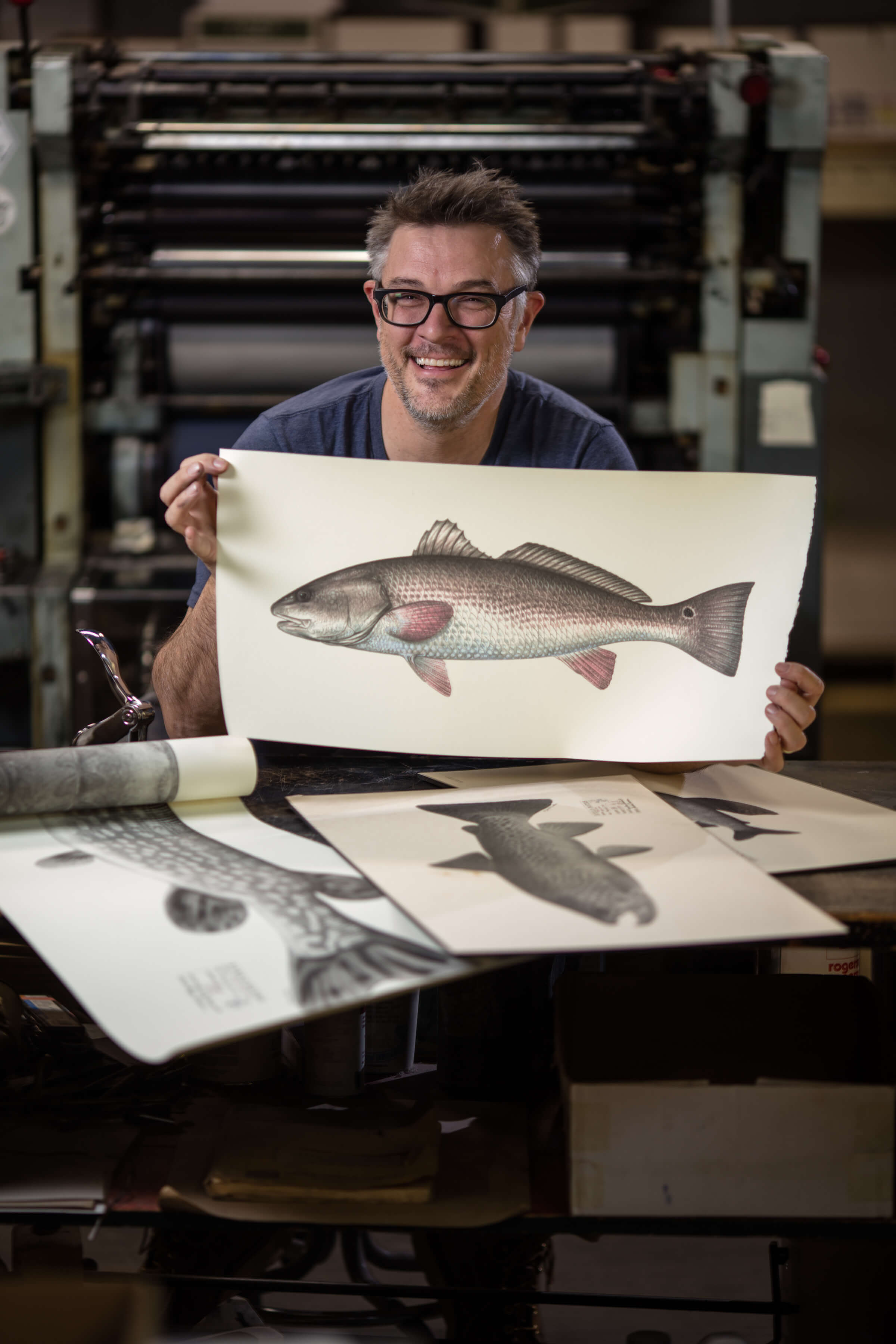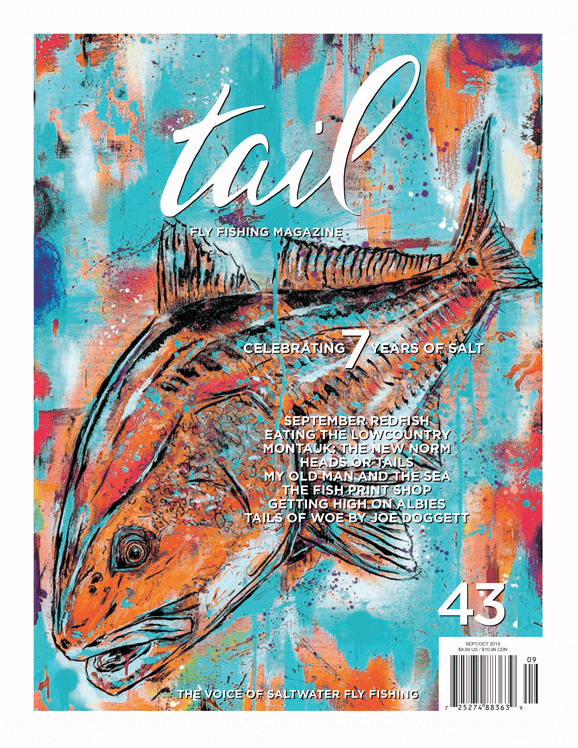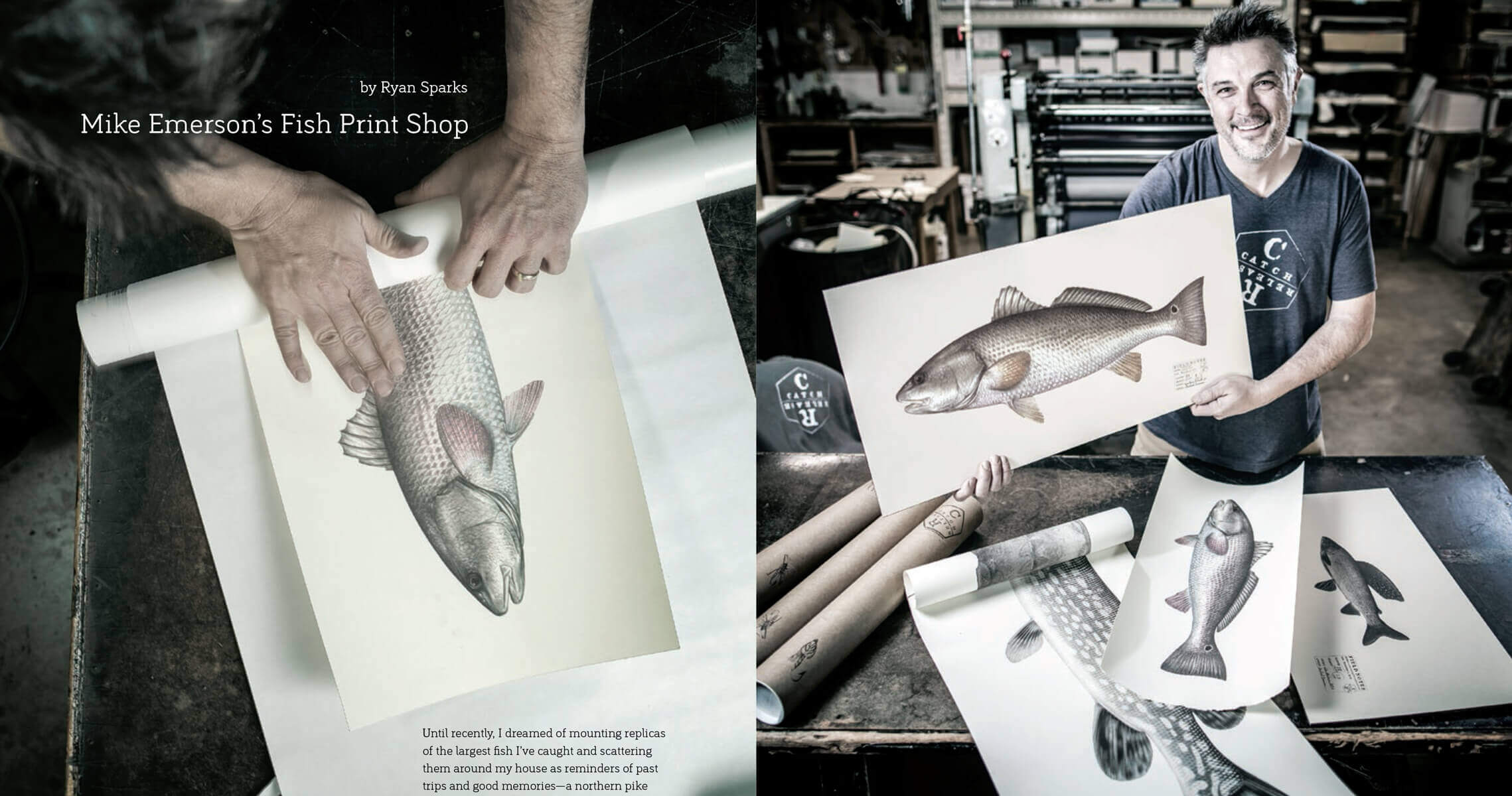Until recently, I dreamed of mounting replicas of the largest fish I’ve caught and scattering them around my house as reminders of past trips and good memories—a northern pike in the living room, a golden trout in my office, a chinook salmon in the kitchen, perhaps a bonefish in the bathroom. Then I discovered Mike Emerson and his Peoria, Illinois-based print shop, aptly named: Fish Print Shop.
For those wanting to commemorate the fish of a lifetime or a special moment, Fish Print Shop creates a life-size print of the fish and stamps it with information about the catch. It’s a great way to remember a day of fishing, the price is considerably lower than most taxidermy, and the fish gets to swim free.
“I got the idea to make a print to the actual length of the fish because I felt that photos never do the fish justice, and even a great photo tends to live on your phone and never gets displayed,” Emerson told me. “I’ve always enjoyed fishing with my sons, and when they would tell people what they caught they always held their hands up to show how big it was. Seeing a fish life-sized is so much more rewarding than a photo. It made sense.”
Emerson created his first prints for friends and family, and soon those gifts turned into a business. He partners with renown fish artists, Joseph R. Tomelleri and Dianne Peebles, whose extensive collection of both freshwater and saltwater illustrations enable Emerson to create replicas of any fish species in North America and many swimming elsewhere. Both artists work with state agencies and conservation organizations to create fish identification guides, and their illustrations have appeared in thousands of publications. If you’ve ever flipped through a fishing regulations pamphlet, you’ve probably seen their work.

Emerson has a background in biology, and his prints look as if they might be torn from a biologist’s field journal. Because of his commitment to collaborating with top artists (he prides himself on paying the highest royalties in the business, which allows him to partner with the best artists around the world), Emerson can depict different morphologies and color phases within a particular species as well as account for girth.
Drawing on such a vast catalog of work, Fish Print Shop has several versions of every species and can match most catches accurately. However, Emerson notes, anglers are sometimes confused in thinking he replicates their exact fish.
“We use a grayscale reproduction of an illustration and print it to size. How that process works is my secret sauce,” he says, laughing. “If the fish has a unique marking or someone really wants their exact fish, I always advocate for local artists. I keep a list of artists who do commissioned work and am happy to recommend someone.”
Emerson’s “secret sauce” produces a timeless result that captures the energy and grandeur of a fish. The clean lines of the grayscale print fit nicely into almost any space, unlike the particular aesthetic of a mounted fish. It’s also more likely to sit well with discerning spouses. In fact, one fisherman’s wife bought him prints to replace his old skin mounts. When Emerson showed up to deliver the prints, she handed him a trunk filled with mounted fish and told him to keep it.
Another advantage of prints over traditional taxidermy is that Fish Print Shop uses archival quality paper and ink, so prints will greatly outlast mounted fish. Emerson says they will last more than a lifetime.
Each print is marked with a customizable stamp that typically notes the date of the catch, length of the fish, angler’s name, and location the fish was caught, but it can be personalized in any manner. Since discovering Fish Print Shop, I’ve had prints made that include who I was fishing with and memorable quotes from the trip.
When I wanted my walls to look like the fishing department of a sporting goods store, the main thing preventing me from doing so was the cost, and a major benefit of Emerson’s prints is their price point.

“We’ve found that with our lower cost, people are more likely to commemorate a 10- or 12-inch fish their kid caught. It doesn’t have to be a monster to make it worth preserving. Some of my favorite prints I’ve done have been for kids, especially my three sons.”
As you can imagine, Emerson gets a lot of requests for trout and says his most popular saltwater fish are redfish and speckled seatrout. He also gets some rare and unusual requests like a 6-foot arapaima, a 17-foot black marlin, and a sea robin an East Coast beachcomber found washed up on shore.
“When we print a new species, I always get a sense of awe as I look at the details,” Emerson told me. “The grayscale really exaggerates the structure and lines of the illustration. It creates something timeless that you might find in a natural history museum, an old aquarium, or a biology classroom. Some people do prefer color prints, and that’s something we can do for certain species. There are restrictions, like when an artist sells limited-edition prints of their work. There are a few fish, like redfish, that I’ve had people specifically ask for in color, but most like the classic look of grayscale.”
Now in the third year since starting his business, Emerson has combined his passion for fishing and printmaking with his commitment to conservation. Fish Print Shop has numerous partnerships with conservation organizations, lodges, and state wildlife agencies, where Emerson will provide free prints to anglers who catch record sized fish and choose to release them.
“Our guiding principles are to promote fisheries conservation by supporting catch-and-release practices and to fairly compensate artists for their work,” Emerson says.
Emerson has created a business that benefits everyone involved: anglers, artists, and the fish they both admire. As anglers, we know that behind every fish there’s a story. Emerson helps anglers relive those stories through beautiful personalized artwork. I no longer have visions of mounted fish in my home, but I’ve got my eye on some empty wall space that could use a print.
Ryan Sparks is the Wild Foods editor of Strung Magazine and his writing has appeared in American Angler, Grey’s Sporting Journal, Meateater, the Drake, the Fly Fish Journal and countless other publications. He is a freelance writer from Minnesota who spends almost all of his time outdoors
THE WEBSITE : https://prints.fish/
 SUBSCRIBE TO TAIL FLY FISHING MAGAZINE
SUBSCRIBE TO TAIL FLY FISHING MAGAZINE


